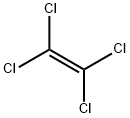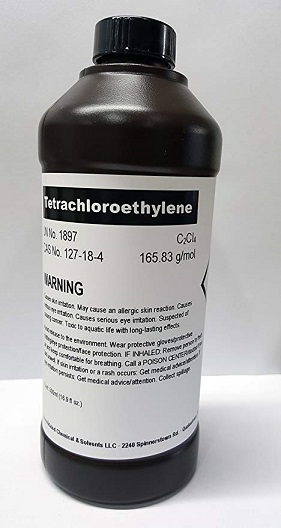General Description
A clear colorless volatile liquid having an ether-like odor. Noncombustible. Insoluble in water. Vapors heavier than air. Density approximately 13.5 lb/gal. Used as dry cleaning solvent, a degreasing solvent, a drying agent for metals, and in the manufacture of other chemicals.
Reactivity Profile
PERCHLOROETHYLENE(127-18-4) decomposes upon heating and exposure to UV light to give phosgene and HCl. Reacts violently with finely dispersed light metals (aluminum) and zinc. [Handling Chemicals Safely 1980 p. 887]. Mixtures with finely divided barium or lithium metal can detonate [ASESB Pot. Incid. 39. 1968; Chem. Eng. News 46(9):38. 1968]. Decomposes very slowly in water to form trichloroacetic acid and hydrochloric acid
Air & Water Reactions
Insoluble in water.
Health Hazard
Vapor can affect central nervous system and cause anesthesia. Liquid may irritate skin after prolonged contact. May irritate eyes but causes no injury.
Potential Exposure
Tetrachloroethylene is used in the textile industry and as a chemical intermediate or a heatexchange fluid; a widely used solvent with particular use as a dry cleaning agent; a degreaser; a fumigant, and medically as an anthelmintic.
Fire Hazard
Special Hazards of Combustion Products: Toxic, irritating gases may be generated in fires.
First aid
If this chemical gets into the eyes, remove any contact lenses at once and irrigate immediately for at least 15 minutes, occasionally lifting upper and lower lids. Seek medical attention immediately. If this chemical contacts the skin, remove contaminated clothing and wash immediately with soap and water. Seek medical attention immediately. If this chemical has been inhaled, remove from exposure, begin rescue breathing (using universal precautions, including resuscitation mask) if breathing has stopped and CPR if heart action has stopped. Transfer promptly to a medical facility. When this chemical has been swallowed, get medical attention. Give large quantities of water and induce vomiting. Do not make an unconscious person vomit. Medical observation is recommended for 24-48 hours after breathing overexposure, as pulmonary edema may be delayed. As first aid for pulmonary edema, a doctor or authorized paramedic may consider administering a drug or other inhalation therapy.
Shipping
UN1897 Tetrachloroethylene, Hazard Class: 6.1; Labels: 6.1-Poisonous materials.
Incompatibilities
Violent reaction with strong oxidizers; powdered, chemically active metals, such as aluminum, lithium, beryllium, and barium; caustic soda; sodium hydroxide; potash. Tetrachloroethylene is quite stable. However, it reacts violently with concentrated nitric acid to give carbon dioxide as a primary product. Slowly decomposes on contact with moisture producing trichloroacetic acid and hydrochloric acid. Decomposes in UV light and in temperatures above 150℃, forming hydrochloric acid and phosgene.
Waste Disposal
Consult with environmental regulatory agencies for guidance on acceptable disposal practices. Generators of waste containing this contaminant (≥100 kg/mo) must conform with EPA regulations governing storage, transportation, treatment, and waste disposal. Incineration, preferably after mixing with another combustible fuel. Care must be exercised to assure complete combustion to prevent the formation of phosgene. An acid scrubber is necessary to remove the halo acids produced. Alternatively, PCE may be recovered from waste gases and reused.
Physical properties
Clear, colorless, nonflammable liquid with a chloroform or sweet, ethereal odor. Odor threshold
concentration is 4.68 ppmv (Leonardos et al., 1969). The average least detectable odor threshold
concentrations in water at 60 °C and in air at 40 °C were 0.24 and 2.8 mg/L, respectively
(Alexander et al., 1982).
Definition
ChEBI: A chlorocarbon that is tetrachloro substituted ethene.
Production Methods
PCE was first prepared in 1821 and commercial production in
the United States began in 1925. Several commercial grades
are available that differ in the amount and type of added
stabilizers (e.g., amines, phenols, and epoxides).
There are currently three U.S. producers with a combined
capacity of 355 million lb. Chem Sources listed in 2001
37 current U.S. suppliers.
Oral doses of about 60–86 mg/kg were given when PCE
was used as an anthelmintic.
Flammability and Explosibility
Nonflammable
Industrial uses
Perchloroethylene is a member of a family of aliphatic halogenated hydrocarbons. It is a colorless, volatile liquid that is essentially nonflammable and has no measurable flash point. It is the primary solvent used in commercial and industrial dry cleaning. Since being introduced to the dry cleaning industry in the late 1930s, it has replaced most other solvents because of its relatively low toxicity and nonflammability. Its other major uses are as a metal cleaning and degreasing solvent, as a solvent in automotive aerosols, and as a chemical intermediate in the production of several fluorinated compounds. The use of perchloroethylene can be broken down into the following categories:
chemical intermediate (~50%)
dry cleaning/textile processing (~25%)
automotive aerosols (~10%)
metal cleaning/degreasing (-10%)
miscellaneous (-5 %)
Perchloroethylene is used as a basic raw material in the manufacture of
hydrofluorocarbon (HFC) 134a, a popular alternative to chlorofluorocarbon (CFC)
refrigerants. It also is used in the synthesis of hydrochlorofluorocarbon (HCFC)
123 and 124 and HFC 125.
Perchloroethylene is used by more than 80 percent of commercial dry cleaners, as
well as some industrial cleaning establishments. It had replaced other synthetic
solvents, such as carbon tetrachloride.
The textile industry uses perchloroethylene as a spotting agent for the removal of
spinning oils and lubricants. It also is used in wool scouring and as a solvent carrier
in dyes and water repellents.
Biochem/physiol Actions
Animal carcinogen that produces increased incidence of renal adenomas, adenocarcinomas, mononuclear cell leukemia, and hepatocellular tumors.
Anticancer Research
PERK, a transmembrane protein, phosphorylates eIF2-alpha which inhibits the synthesisof new proteins and folding of the existing proteins. In addition, the activatingtranscription factor 4 (ATF4) expression is selectively induced by eIF2α phosphorylation,which induces upregulation of UPR genes and growth arrest, including ERoxidoreductase1α, CCAAT/enhancer-binding protein-homologous protein (CHOP)and various pro-apoptotic factors (Quick and Faison 2012; Carreras et al. 2017).Haem-regulated eIF2α kinase and multiple kinases including protein kinase R alsoinduce eIF2α phosphorylation. The integrated stress response (ISR) is referred to assignalling related to eIF2α phosphorylation. Nuclear factor (erythroid-derived2)-like 2 (Nrf-2) is another substrate which upon phosphorylation dissociates fromits cytoskeletal anchor and goes and binds to antioxidant redox element (ARE) inthe nucleus. It has twofold part to play in cancer, oncogenic function and tumoursuppressor function depending upon the ER stress in the cell. In normal circumstances,Nrf-2 interacts with kelch-like ECH-associated protein I to preserve theinactive state in the cytoplasm. PERK dissociates phosphorylated Nrf-2 from kelchlikeECH-associated protein I, which results in its translocation from membrane tothe nucleus and antioxidant genes getting expressed promoting cell survival.
For survival of the tumour during nutrient starvation and hypoxia, it is considerednecessary for the ISR and PERK signalling to get activated. Reactive oxygenspecies (ROS) concentration is increased as a result of oxidative stress and hypoxia.Additionally, PERK signalling upregulates ER oxidoreductase1α that controls ERredox status. As notified in different kinds of cancers, due to upsurge in the levels ofROS in tumours, ER oxidoreductase 1α is overexpressed (Wang et al. 2014).Inhibition of ISR or PERK signalling causes production of ROS that restricts growthof tumour by means of oxidative DNA damage. Retorting to prolonged and intenseER stress, cell death is induced by CHOP, a transcription factor and a downstreamtarget of ATF4 (Hiramatsu et al. 2014). Hence there are possibilities of ISR andPERK being the therapeutic targets for cancer on account of their dual role insignalling pathways (Farooqi et al. 2015).
Carcinogenicity
Tetrachloroethylene is reasonably anticipated to be a human carcinogen based on sufficient evidence of carcinogenicity from studies in experimental animals.
Environmental Fate
Biological. Sequential dehalogenation by microbes under laboratory conditions produced
trichloroethylene, cis-1,2-dichloroethylene, trans-1,2-dichloroethylene, and vinyl chloride (Smith and Dragun, 1984). A microcosm composed of aquifer water and sediment collected from
uncontaminated sites in the Everglades biotransformed tetrachloroethylene to cis- and trans-1,2-
dichloroethylene (Parsons and Lage, 1985). Microbial degradation to trichloroethylene under
anaerobic conditions or using mixed cultures was also reported (Vogel et al., 1987).
Surface Water. Estimated half-lives of tetrachloroethylene (3.2 μg/L) from an experimental
marine mesocosm during the spring (8–16 °C), summer (20–22 °C), and winter (3–7 °C) were 28,
13, and 15 d, respectively (Wakeham et al., 1983).
Photolytic. Photolysis in the presence of nitrogen oxides yielded phosgene (carbonyl chloride)
with minor amounts of carbon tetrachloride, dichloroacetyl chloride, and trichloroacetyl chloride
(Howard, 1990). In sunlight, photolysis products reported include chlorine, hydrogen chloride, and
trichloroacetic acid. Tetrachloroethylene reacts with ozone to produce a mixture of phosgene and
trichloroacetyl chloride with a reported half-life of 8 d (Fuller, 1976). Reported photooxidation
products in the troposphere include trichloroacetyl chloride and phosgene (Andersson et al., 1975;
Gay et al., 1976; U.S. EPA, 1975). Phosgene is hydrolyzed readily to hydrogen chloride and
carbon dioxide (Morrison and Boyd, 1971).
Chemical/Physical. The experimental half-life for hydrolysis of tetrachloroethylene in water at
25 °C is 8.8 months (Dilling et al., 1975).
Purification Methods
It decomposes under similar conditions to CHCl3, to give phosgene and trichloroacetic acid. Inhibitors of this reaction include EtOH, diethyl ether and thymol (effective at 2-5ppm). Tetrachloroethylene should be distilled under a vacuum (to avoid phosgene formation) and stored in the dark out of contact with air. It can be purified by washing with 2M HCl until the aqueous phase no longer becomes coloured, then with water, drying with Na2CO3, Na2SO4, CaCl2 or P2O5, and fractionally distilling just before use. 1,1,2-Trichloroethane and 1,1,1,2-tetrachloroethane can be removed by counter-current extraction with EtOH/water. [Beilstein 1 IV 715.]
Toxicity evaluation
PCE is metabolized to TCA and other trichloro metabolites in
the liver. Trichloroacetic acid has been shown to produce
peroxisome proliferation in mice. This may have implications
for the apparent increase in liver tumors in mice. PCE also has
been shown to distribute rapidly to the central nervous system
(CNS) and is known to have an affinity for the lipophilic
cellular membranes in the brain.
As with most chlorinated solvents, acute exposure to PCE
primarily affects the CNS and causes skin, throat, and eye irritation.
In addition to affecting the CNS and skin, PCE may also
adversely affect the liver and kidneys. It may harm the fetus and
newborns through maternal exposure. CNS effects may be
reversible once exposure ends. Hepatic and renal toxicity may
occur in humans exposed to PCE. PCE may affect the heart;
however, no deaths due to cardiotoxicity have been reported in
workers. Several studies have reported reproductive or developmental
abnormalities due to exposure to PCE in drinking water.
An acute exposure to a large concentration or dose of PCE
can produce arrhythmias and pulmonary edema. This may be due to a decrease in the myocardial threshold to the arrhythmogenic
effects of epinephrine. Chronic exposure to PCE may
cause ventricular arrhythmia or cardiomyopathy.
PCE metabolism via cytochrome P450 generates the
metabolites dichloroacetic acid (DCA) and trichloroacetic acid
(TCA), which are associated with hepatotoxicity and liver
cancer. DCA and TCA may induce hepatic tumorigenesis by (1)
modification of signaling pathways; (2) cytotoxicity, cell death,
and reparative hyperplasia; and (3) direct DNA damage.
PCE metabolism via glutathione conjugation generates S-
(1,2,2-trichlorovinyl)glutathione (TCVG), which is associated
with nephrotoxicity and kidney cancer. TCVG can be both
bioactivated and detoxified by different enzymes. The enzyme
that is primarily responsible for renal bioactivation of nephrotoxic
cysteine S-conjugates is b-lyase. The reactive thiol and
subsequent species generated from b-lyase-catalyzed metabolism
of TCVG may induce renal tumorigenesis by (1) peroxisome
proliferation, (2) a-2u-globulin nephropathy, (3)
genotoxicity leading to somatic mutation, and (4) acute cytotoxicity
and necrosis leading to cell proliferation.

